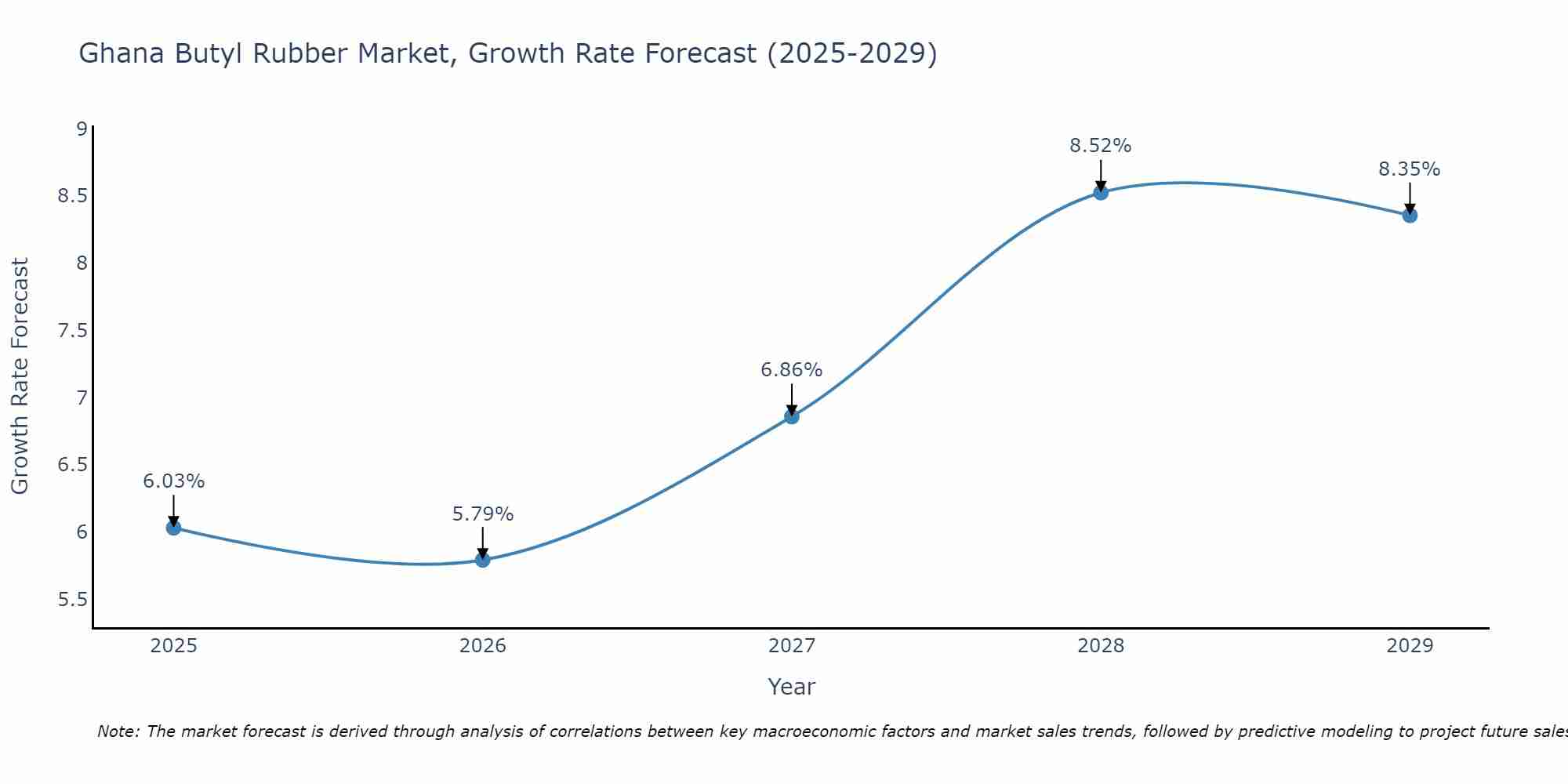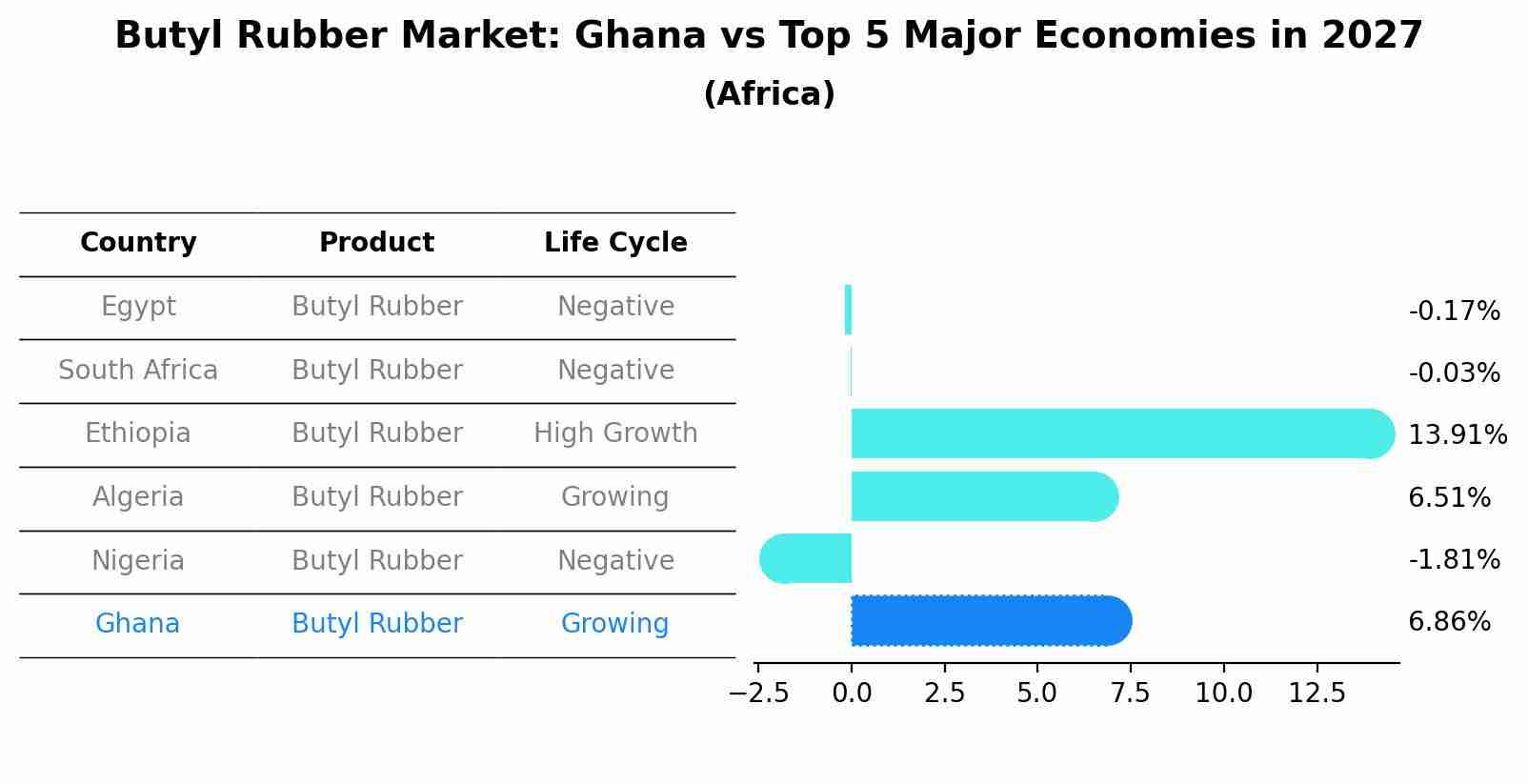Ghana Butyl Rubber Market (2025-2031) Outlook | Forecast, Size, Industry, Growth, Companies, Value, Revenue, Share, Trends & Analysis
| Product Code: ETC316436 | Publication Date: Aug 2022 | Updated Date: Aug 2025 | Product Type: Market Research Report | |
| Publisher: 6Wresearch | Author: Shubham Padhi | No. of Pages: 75 | No. of Figures: 35 | No. of Tables: 20 |
Ghana Butyl Rubber Market Size Growth Rate
The Ghana Butyl Rubber Market is projected to witness mixed growth rate patterns during 2025 to 2029. Starting at 6.03% in 2025, the market peaks at 8.52% in 2028, and settles at 8.35% by 2029.

Butyl Rubber Market: Ghana vs Top 5 Major Economies in 2027 (Africa)
Ghana's Butyl Rubber market is anticipated to experience a growing growth rate of 6.86% by 2027, reflecting trends observed in the largest economy Egypt, followed by South Africa, Ethiopia, Algeria and Nigeria.

Ghana Butyl Rubber Market Overview
The Ghana Butyl Rubber Market is witnessing growth propelled by factors such as automotive industry expansion, tire manufacturing demand, and infrastructure development. Butyl rubber, a synthetic elastomer known for its impermeability to gases, weather resistance, and damping properties, serves as a key material in tire production, automotive seals, construction seals, and industrial applications in Ghana, contributing to its demand in various sectors.
Drivers of the market
The butyl rubber market in Ghana is driven by the demand for synthetic elastomers with superior impermeability, flexibility, and weather resistance properties in tire manufacturing and automotive applications. Butyl rubber, derived from polymerizing isobutylene with small amounts of isoprene, offers advantages such as low gas permeability, heat resistance, and damping characteristics, enhancing tire performance, durability, and fuel efficiency.
Challenges of the market
The Ghana butyl rubber market encounters challenges including raw material availability, production costs, and market competition. Butyl rubber, a synthetic elastomer derived from petroleum-based monomers, is used in various applications, including tire manufacturing, automotive components, and industrial seals, due to its excellent impermeability to gases and liquids. However, securing a stable supply of butyl rubber monomers, such as isobutylene and isoprene, amid fluctuations in oil prices and feedstock availability, may pose challenges for producers. Moreover, managing production costs, including energy consumption, chemical inputs, and waste management, can impact the competitiveness and profitability of butyl rubber manufacturing. Additionally, addressing competition from alternative elastomers, such as natural rubber, styrene-butadiene rubber (SBR), and ethylene propylene diene monomer (EPDM), may influence market dynamics and pricing strategies. Addressing these challenges through supply chain optimization, cost efficiency measures, and market differentiation strategies is essential to support the growth of the butyl rubber market in Ghana and enhance the competitiveness of the country`s rubber industry.
Government Policy of the market
Government policies in the butyl rubber market may focus on promoting industrial competitiveness, innovation, and sustainability in the rubber industry. Initiatives might include investment in research and development to support the development of advanced butyl rubber formulations with improved performance and environmental sustainability. Additionally, the government may offer financial incentives or subsidies for the adoption of butyl rubber in manufacturing processes such as tire production to reduce dependence on imported raw materials and enhance domestic value-added production. Capacity-building programs for rubber scientists and engineers on butyl rubber technology and applications may also be supported to facilitate innovation and knowledge transfer in the industry.
Key Highlights of the Report:
- Ghana Butyl Rubber Market Outlook
- Market Size of Ghana Butyl Rubber Market, 2024
- Forecast of Ghana Butyl Rubber Market, 2031
- Historical Data and Forecast of Ghana Butyl Rubber Revenues & Volume for the Period 2021-2031
- Ghana Butyl Rubber Market Trend Evolution
- Ghana Butyl Rubber Market Drivers and Challenges
- Ghana Butyl Rubber Price Trends
- Ghana Butyl Rubber Porter's Five Forces
- Ghana Butyl Rubber Industry Life Cycle
- Historical Data and Forecast of Ghana Butyl Rubber Market Revenues & Volume By Product Type for the Period 2021-2031
- Historical Data and Forecast of Ghana Butyl Rubber Market Revenues & Volume By Regular Butyl Rubber for the Period 2021-2031
- Historical Data and Forecast of Ghana Butyl Rubber Market Revenues & Volume By Halo Butyl Rubber for the Period 2021-2031
- Historical Data and Forecast of Ghana Butyl Rubber Market Revenues & Volume By Bromo-Butyl Rubber for the Period 2021-2031
- Historical Data and Forecast of Ghana Butyl Rubber Market Revenues & Volume By Chloro-Butyl Rubber for the Period 2021-2031
- Historical Data and Forecast of Ghana Butyl Rubber Market Revenues & Volume By Application for the Period 2021-2031
- Historical Data and Forecast of Ghana Butyl Rubber Market Revenues & Volume By Tires & Tubes for the Period 2021-2031
- Historical Data and Forecast of Ghana Butyl Rubber Market Revenues & Volume By Pharmaceuticals for the Period 2021-2031
- Historical Data and Forecast of Ghana Butyl Rubber Market Revenues & Volume By Adhesives & Sealants for the Period 2021-2031
- Historical Data and Forecast of Ghana Butyl Rubber Market Revenues & Volume By Automotive for the Period 2021-2031
- Historical Data and Forecast of Ghana Butyl Rubber Market Revenues & Volume By Others for the Period 2021-2031
- Ghana Butyl Rubber Import Export Trade Statistics
- Market Opportunity Assessment By Product Type
- Market Opportunity Assessment By Application
- Ghana Butyl Rubber Top Companies Market Share
- Ghana Butyl Rubber Competitive Benchmarking By Technical and Operational Parameters
- Ghana Butyl Rubber Company Profiles
- Ghana Butyl Rubber Key Strategic Recommendations
Frequently Asked Questions About the Market Study (FAQs):
1 Executive Summary |
2 Introduction |
2.1 Key Highlights of the Report |
2.2 Report Description |
2.3 Market Scope & Segmentation |
2.4 Research Methodology |
2.5 Assumptions |
3 Ghana Butyl Rubber Market Overview |
3.1 Ghana Country Macro Economic Indicators |
3.2 Ghana Butyl Rubber Market Revenues & Volume, 2021 & 2031F |
3.3 Ghana Butyl Rubber Market - Industry Life Cycle |
3.4 Ghana Butyl Rubber Market - Porter's Five Forces |
3.5 Ghana Butyl Rubber Market Revenues & Volume Share, By Product Type, 2021 & 2031F |
3.6 Ghana Butyl Rubber Market Revenues & Volume Share, By Application, 2021 & 2031F |
4 Ghana Butyl Rubber Market Dynamics |
4.1 Impact Analysis |
4.2 Market Drivers |
4.2.1 Growth in the automotive industry leading to increased demand for butyl rubber in tire manufacturing. |
4.2.2 Expansion of the construction sector in Ghana driving the demand for butyl rubber in sealants and adhesives. |
4.2.3 Government initiatives promoting industrial development and investment in infrastructure projects fueling the demand for butyl rubber. |
4.3 Market Restraints |
4.3.1 Fluctuations in raw material prices impacting the production cost of butyl rubber. |
4.3.2 Competition from alternative materials such as natural rubber affecting the market share of butyl rubber. |
4.3.3 Regulatory challenges related to environmental concerns and waste management in butyl rubber production. |
5 Ghana Butyl Rubber Market Trends |
6 Ghana Butyl Rubber Market, By Types |
6.1 Ghana Butyl Rubber Market, By Product Type |
6.1.1 Overview and Analysis |
6.1.2 Ghana Butyl Rubber Market Revenues & Volume, By Product Type, 2021-2031F |
6.1.3 Ghana Butyl Rubber Market Revenues & Volume, By Regular Butyl Rubber, 2021-2031F |
6.1.4 Ghana Butyl Rubber Market Revenues & Volume, By Halo Butyl Rubber, 2021-2031F |
6.1.5 Ghana Butyl Rubber Market Revenues & Volume, By Bromo-Butyl Rubber, 2021-2031F |
6.1.6 Ghana Butyl Rubber Market Revenues & Volume, By Chloro-Butyl Rubber, 2021-2031F |
6.2 Ghana Butyl Rubber Market, By Application |
6.2.1 Overview and Analysis |
6.2.2 Ghana Butyl Rubber Market Revenues & Volume, By Tires & Tubes, 2021-2031F |
6.2.3 Ghana Butyl Rubber Market Revenues & Volume, By Pharmaceuticals, 2021-2031F |
6.2.4 Ghana Butyl Rubber Market Revenues & Volume, By Adhesives & Sealants, 2021-2031F |
6.2.5 Ghana Butyl Rubber Market Revenues & Volume, By Automotive, 2021-2031F |
6.2.6 Ghana Butyl Rubber Market Revenues & Volume, By Others, 2021-2031F |
7 Ghana Butyl Rubber Market Import-Export Trade Statistics |
7.1 Ghana Butyl Rubber Market Export to Major Countries |
7.2 Ghana Butyl Rubber Market Imports from Major Countries |
8 Ghana Butyl Rubber Market Key Performance Indicators |
8.1 Capacity utilization rate of butyl rubber manufacturing plants in Ghana. |
8.2 Percentage of butyl rubber used in the automotive sector compared to other applications. |
8.3 Research and development expenditure focused on improving the quality and properties of butyl rubber. |
9 Ghana Butyl Rubber Market - Opportunity Assessment |
9.1 Ghana Butyl Rubber Market Opportunity Assessment, By Product Type, 2021 & 2031F |
9.2 Ghana Butyl Rubber Market Opportunity Assessment, By Application, 2021 & 2031F |
10 Ghana Butyl Rubber Market - Competitive Landscape |
10.1 Ghana Butyl Rubber Market Revenue Share, By Companies, 2024 |
10.2 Ghana Butyl Rubber Market Competitive Benchmarking, By Operating and Technical Parameters |
11 Company Profiles |
12 Recommendations |
13 Disclaimer |
- Single User License$ 1,995
- Department License$ 2,400
- Site License$ 3,120
- Global License$ 3,795
Search
Related Reports
- ASEAN and Thailand Brain Health Supplements Market (2025-2031) | Strategy, Consumer Insights, Analysis, Investment Trends, Opportunities, Growth, Size, Share, Industry, Revenue, Segments, Value, Segmentation, Supply, Forecast, Restraints, Outlook, Competition, Drivers, Trends, Demand, Pricing Analysis, Competitive, Strategic Insights, Companies, Challenges
- ASEAN Bearings Market (2025-2031) | Strategy, Consumer Insights, Analysis, Investment Trends, Opportunities, Growth, Size, Share, Industry, Revenue, Segments, Value, Segmentation, Supply, Forecast, Restraints, Outlook, Competition, Drivers, Trends, Demand, Pricing Analysis, Competitive, Strategic Insights, Companies, Challenges
- Europe Flooring Market (2025-2031) | Outlook, Share, Industry, Trends, Forecast, Companies, Revenue, Size, Analysis, Growth & Value
- Saudi Arabia Manlift Market (2025-2031) | Outlook, Size, Growth, Trends, Companies, Industry, Revenue, Value, Share, Forecast & Analysis
- Uganda Excavator, Crane, and Wheel Loaders Market (2025-2031) | Strategy, Consumer Insights, Analysis, Investment Trends, Opportunities, Growth, Size, Share, Industry, Revenue, Segments, Value, Segmentation, Supply, Forecast, Restraints, Outlook, Competition, Drivers, Trends, Demand, Pricing Analysis, Competitive, Strategic Insights, Companies, Challenges
- Rwanda Excavator, Crane, and Wheel Loaders Market (2025-2031) | Strategy, Consumer Insights, Analysis, Investment Trends, Opportunities, Growth, Size, Share, Industry, Revenue, Segments, Value, Segmentation, Supply, Forecast, Restraints, Outlook, Competition, Drivers, Trends, Demand, Pricing Analysis, Competitive, Strategic Insights, Companies, Challenges
- Kenya Excavator, Crane, and Wheel Loaders Market (2025-2031) | Strategy, Consumer Insights, Analysis, Investment Trends, Opportunities, Growth, Size, Share, Industry, Revenue, Segments, Value, Segmentation, Supply, Forecast, Restraints, Outlook, Competition, Drivers, Trends, Demand, Pricing Analysis, Competitive, Strategic Insights, Companies, Challenges
- Angola Excavator, Crane, and Wheel Loaders Market (2025-2031) | Strategy, Consumer Insights, Analysis, Investment Trends, Opportunities, Growth, Size, Share, Industry, Revenue, Segments, Value, Segmentation, Supply, Forecast, Restraints, Outlook, Competition, Drivers, Trends, Demand, Pricing Analysis, Competitive, Strategic Insights, Companies, Challenges
- Israel Intelligent Transport System Market (2025-2031) | Strategy, Consumer Insights, Analysis, Investment Trends, Opportunities, Growth, Size, Share, Industry, Revenue, Segments, Value, Segmentation, Supply, Forecast, Restraints, Outlook, Competition, Drivers, Trends, Demand, Pricing Analysis, Competitive, Strategic Insights, Companies, Challenges
- Uganda Precast and Aggregate Market (2025-2031) | Strategy, Consumer Insights, Analysis, Investment Trends, Opportunities, Growth, Size, Share, Industry, Revenue, Segments, Value, Segmentation, Supply, Forecast, Restraints, Outlook, Competition, Drivers, Trends, Demand, Pricing Analysis, Competitive, Strategic Insights, Companies, Challenges
Industry Events and Analyst Meet
Our Clients
Whitepaper
- Middle East & Africa Commercial Security Market Click here to view more.
- Middle East & Africa Fire Safety Systems & Equipment Market Click here to view more.
- GCC Drone Market Click here to view more.
- Middle East Lighting Fixture Market Click here to view more.
- GCC Physical & Perimeter Security Market Click here to view more.
6WResearch In News
- Doha a strategic location for EV manufacturing hub: IPA Qatar
- Demand for luxury TVs surging in the GCC, says Samsung
- Empowering Growth: The Thriving Journey of Bangladesh’s Cable Industry
- Demand for luxury TVs surging in the GCC, says Samsung
- Video call with a traditional healer? Once unthinkable, it’s now common in South Africa
- Intelligent Buildings To Smooth GCC’s Path To Net Zero













